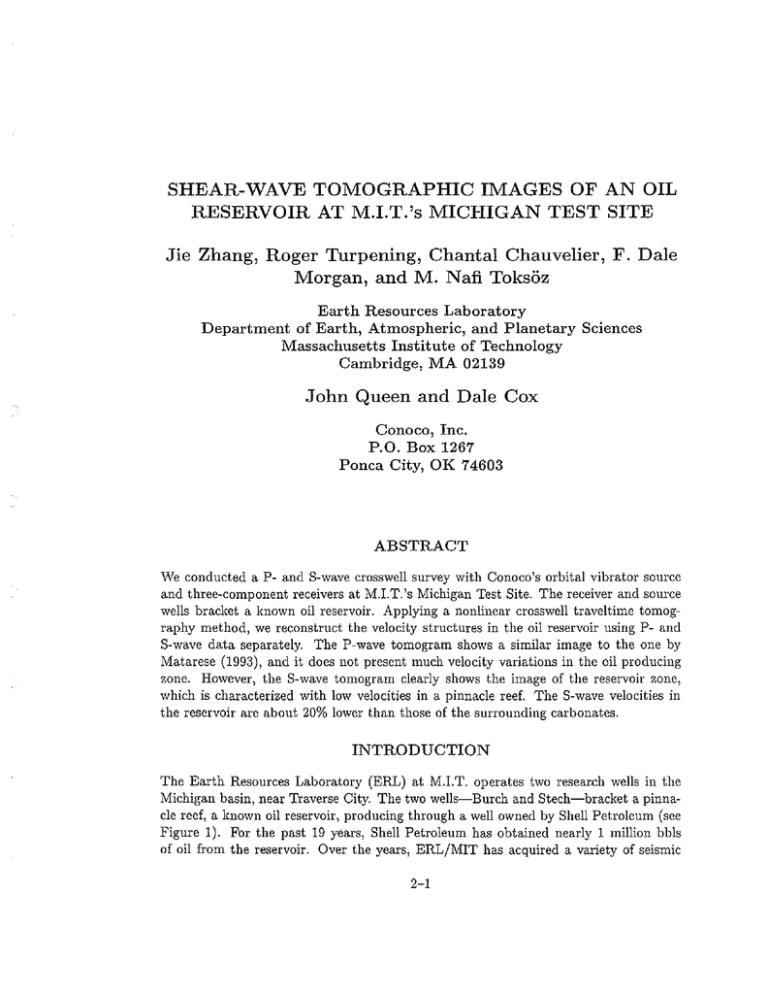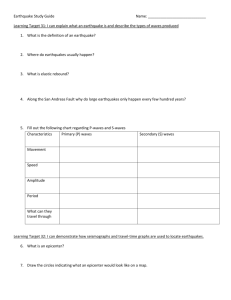OIL RESERVOIR AT M.LT.'s MICHIGAN TEST SITE
advertisement

SHEAR-WAVE TOMOGRAPHIC IMAGES OF AN OIL
RESERVOIR AT M.LT.'s MICHIGAN TEST SITE
Jie Zhang, Roger Turpening, Chantal Chauvelier, F. Dale
Morgan, and M. N afi Toksoz
Earth Resources Laboratory
Department of Earth, Atmospheric, and Planetary Sciences
Massachusetts Institute of Technology
Cambridge, MA 02139
John Queen and Dale Cox
Conoco, Inc.
P.O. Box 1267
Ponca City, OK 74603
ABSTRACT
\Ve conducted a P- and S-wave crosswell survey with Conoco's orbital vibrator source
and three-component receivers at M.LT.'s Michigan Test Site. The receiver and source
wells bracket a known oil reservoir. Applying a nonlinear crosswell traveltime tomography method, we reconstruct the velocity structures in the oil reservoir using P- and
S-wave data separately. The P-wave tomogram shows a similar image to the one by
Matarese (1993), and it does not present much velocity variations in the oil producing
zone. However, the S-wave tomogram clearly shows the image of the reservoir zone,
which is characterized with low velocities in a pinnacle reef. The S-wave velocities in
the reservoir are about 20% lower than those of the surrounding carbonates.
INTRODUCTION
The Earth Resources Laboratory (ERL) at M.LT. operates two researeh wells in the
Michigan basin, near Traverse City. The two wells-Burch and Stech-bracket a pinnacle reef, a known oil reservoir, producing through a well owned by Shell Petroleum (see
Figure 1). For the past 19 years, Shell Petroleum has obtained nearly 1 million bbls
of oil from the reservoir. Over the years, ERL/MIT has acquired a variety of seismic
2-1
(
Zhang et al.
data sets over the pinnacle reef, including a 3-D reflection survey, VSP and crosswell
experiments. In 1990 and 1991, BP America Inc. acquired crosswell P-wave data using
a piezoelectric source and hydrophone at M.I.To's Michigan test site (Lee et al., 1992).
Applying a nonlinear traveltime tomography method, Matarese (1993) inverted BP's
crosswell data to reconstruct a tomographic image of the reef. All of these previous results, within their limits of resolution, provide us with knowledge of the reef. However,
most of them present a view of the carbonate layers (AI Carbonate, Al Evaporite, A2
Carbonate, A2 Evaporite) that overlay the reef, but with little or no knowledge of the
reef material itself. While this is sufficient for the exploration phase (i.e., finding the
reef), it does not help in reserves estimation or reservoir development.
In 1995, we conducted the second crosswell experiment at the test site with Conoco's
orbital vibrator source and three-component receivers. The source is sufficiently powerful for a recording range up to 4,000 ft. Its frequency range is between 70 and 380 Hz.
This source can be decomposed into one that is "inline," i.e., in the plane containing
the two boreholes, and another one that is "crossline," i.e., perpendicular to that plane.
Therefore, the source can generate both P- and S-wave energy. Figure 2 shows the H-l
component recording from an inline source in which P waves dominate, and the H-2
component recording from a crossline source which shows SH waves. The receiver is at
a depth of 4,936 ft.
The design of the optimal acquisition parameters became an important issue prior to
the crosswell experiment in 1995. The goal of the survey was to image the oil producing
zone beneath the Al Carbonate. Therefore, we had to generate steep ray paths such that
energy actually penetrates the producing zone instead of propagating across the region
as head waves in the Al and A2 carbonates. Using the P-wave velocity model from
Matarese (1993), we applied a raytracing method to design optimal source and receiver
geometries for a better ray coverage in the target zone (Chauvelier et al., 1996). This
led to a decision that applies smaller source and receiver spacings near the top and
bottom of the survey zone.
In this paper, we present a new crosswell tomography method and its application
to the crosswell data acquired in the 1995 experiment. Both P- and S-wave tomograms
are reconstructed, and the results clearly show the image of the oil reservoir, which
is characterized with low velocities. The S-wave image of the reservoir seems better
resolved, because of larger traveltime delays through the reef.
(
(
(
(
NONLINEAR TRAVELTIME TOMOGRAPHY METHOD
We apply a rapid structure-driven wavefront method (Zhang and Toksiiz, 1996) to
calculate P- or S-wave traveltimes for a given velocity structure. The approach applies
graph theory to expand a wavefront from the source and calculates traveltimes through
the entire model. It accounts for many wave effects such as diffraction and head waves.
Prior to raytracing, we calculate the spatial derivatives of the model and generate sparse
traveltime nodes in the model grid by eliminating the nodes where the derivatives are
(
(
2-2
S-Wave Tomographic Images
too small. This procedure helps reduce computational efforts and increases calculation
accuracy.
We solve a regularized nonlinear inverse problem. In particular, we invert traveltime
curves by fitting both traveltimes and their derivatives. Specifically, we minimize the
following objective function,
<Ji(m) = (1 - w)lld - G(m)11 2 + wllDx(d - G(m))11 2 + .,-IIR(ma - m)1I
2
(1)
where d is traveltime data; m is the model parameter, G(m) is the calculated data; D x
is a derivative operator; Dx(d) gives traveltime derivatives with respect to distance; R
is a regularization operator (we chose it to be a Laplacian operator); ma is an a priori
model where we put sonic log constraints; w is a data weighting parameter; and .,- is
a trade-off parameter for regularization. To minimize the above objective function, we
apply a nonlinear Conjugate Gradient Method.
Numerical experiments show that inverting traveltime curves rather than traveltimes
gives a more meaningful data fit and maintains a wave resolution as it is implied in the
data (Zhang and Toks6z, 1996).
IMAGING THE OIL RESERVOIR
To image the oil reservoir using P- and S-wave data collected from M.L T.'s research
wells, we apply the nonlinear traveltime tomography method to invert P- and S-wave
velocities separately. The purpose of separate inversions is to understand the independent information of reservoir structure in each type of data. In this study, we used
12,400 P- and S-wave first arrival traveltime picks out of a possible 62,000 for the array
of 200 sources by 155 receivers. Therefore, the current results are preliminary.
With a grid spacing of 15 ft, we grid the image area (2,100 ft x 3,015 ft) with
141 x 201 cells. In addition to the traveltime data, full waveform sonic logs from receiver
and source wells provided slowness information along the borehole trajectories. We
construct an a priori model ma with this additional information included, and apply it to
the inversion as described in equation (1). Matarese (1993) inverted P-wave traveltime
data that were acquired during a crosswell experiment in 1993 at the same site and
constructed an image from depth 3,500 ft to 5,500 ft. To make a starting model for
P-wave traveltime inversion, we extend his image on the basis of well logs to a range
of depths from 3,285 ft to 6,300 ft, and replace the image at depths from 4,500 ft to
5,500 ft with a constant velocity. The starting model for S-wave inversion is created by
scaling the initial model for P-wave inversion with a factor of 1/1.73.
Figure 3 shows the inversion results. Both P- and S-wave tomograms clearly show
a low-velocity zone in the reef. This low-velocity image did not appear in the previous
tomogram constructed by Matarese (1993). In particular, the S-wave velocities in the
zone are about 20% lower than those of the surrounding carbonates. We found this
low-velocity image area well corresponds to a porous and permeable reservoir that was
inferred from Shell's log data. The porosity in the reservoir is about 10%. Currently
this reservoir zone is mostly saturated with water, and oil production is in the late stage.
2-3
Zhang et al.
CONCLUSIONS
The crosswell experiment in 1995 at M.LT. 's Michigan test site successfully provided
P- and S-wave data for high-resolution tomographic imaging.. We owe this success to
Conoco's orbital vibrator source and three-component receivers, and also to the optimal
survey design and new tomography approach. The tomographic images gave us a new
look and new understanding in the reservoir.
(
(
ACKNOWLEDGMENTS
This work was supported by the Reservoir Delineation Consortium at the Massachusetts
Institute of Technology.
(
(
(
(
2-4
(
S- Wave Tomographic Images
REFERENCES
Chauvelier, C., R. Turpening, and J. Queen, 1996, 1995 Data acquisition program at
the Michigan Reservoir Delineation research facility, M.LT. Earth Resources Laboratory Borehole Acoustics Logging and Reservoir Delineation Consortia 1996 Annual
Report.
Lee, J., J. Matarese, M.N. Toksiiz, and W. Turpening, 1992, Nonlinear traveltime tomography applied to MIT's Michigan test site, Geotomography, Proc. 2nd SEGljSEG
Internat. Symp. on Geotomography, 457-472.
Matarese, J., 1993, Nonlinear traveltime tomography, Ph.D. Thesis, Massachusetts Institute of Technology.
Zhang, J. and M.N. Toksiiz, 1996, Nonlinear refraction traveltime tomography, Expanded
Abstracts, 66th Ann. Internat. SEG Mtg., 2011-2014.
2-5
Zhang et at.
Michigan Test Site Geology
offset (tt)
W
01
o
o
500
1000
I
I
F Salt I
StrinJJcr in F Salt
~
o
o
o
F Salt II
.
E Unit Shale
C Shale
..... Stringer in F Salt
B Salt
~
01
o
o
A2 Carbonate
A2 Salt
Al Carbo
Al Salt
Brown Nia~aran
(ReservOir)
••
•
••
••
•
•
••
•
••
•
••
••
•
••
•
••
•
••
•
"
01
o
o
o
-
2000
MIT/Stech 1-21A
(source well)
Vp = 14,400 €Us
Vn = 18 300 fUs
Vo = 14.400 €Us
Vp = 15,500 ftls
Vn = 14.000 ftls
(
....... Vp = 17,000 ftls
Vp = 14,900 fUs
-......;::::::
Vp = 21,300ftfs
•
Vp _ 21,500 ftls
-
-
vp = 22,500 ftls
Vp = 14.900 ftIs
Vp = 23,000 ftls
Vp = 14,900 ftls
Vp = 19.000 ftls
Gray Niagaran
01
01
•
• Shell
MITlBurch 1-20B
(receiver well)
o
1500
.".. Schoolcraft Carbonate
~ Vo,... 22.000 ftls
Burnt Bluff Carbonate
Vp = 21,500 ftIs
o
o
Figure 1: Geology of the ERL/MIT Michigan test site for the 3500-5500 ft depth
interval.
2-6
S-Wave Tomographic Images
inline source, H-1 component
crossline source, H-2 component
3303
3303
.J::
15.
Q)
o
4936
4936
6279
50
200
100
250
6279
100
Time (ms)
200
Time (ms)
300
Figure 2: Crosswell data recorded at a receiver at a depth of 4936 ft. The H-l component
from the inline source mainly shows P waves, and the H-2 component from the
crossline source shows SH waves.
2-7
(
Zhang et al.
P-wave Tomogram
S-wave Tomogram
Offset (tt)
-150
3285
1000
Offset (tt)
1950
-.150
3285
·..·.1000
. 1950
,"
4000
4000
~
~
:=
:=
..c:
..c:
-
-
~
~
0.
Ql
C
0.
Ql
5000
C
5000
6000
6000
6300
6300
~!1i·l·
12500
20000
--'-'!!Ii'i'!1('/j
_'\'11
23000
P-wave Velocity (ftIs)
7600
9000
11 000
13000
S-wave Velocity (ftIs)
(
Figure 3: P- and S-wave velocity reconstruction using traveltime data and slowness logs.
2-8







